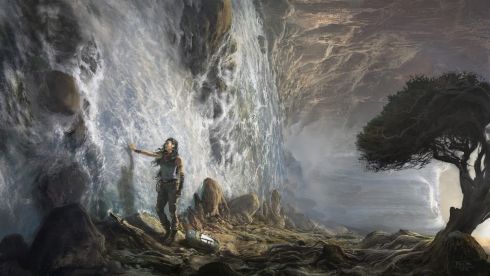Lower Water (spell)
| Range | 20 ft./level |
| Duration | 10 rounds per level |
| Area of Effect | 8000 cub.ft. per level |
| Casting Time | 2 rounds |
| Saving Throw | none |
| Level | cleric (4th) |
Lower water causes the surface of a body of water to lower in the desired area of effect; likewise, this effect can be reversed, so that the level of water is raised. The water is neither destroyed nor compressed; rather, it is temporarily transferred to, or drawn from, the Plane of Water. Water can only be raised from an earthen surface; it cannot be raised upon a constructed wooden, stone or cobbled platform, such as a foundation or road.
Mechanics
If only part of the surface is adjusted, it will appear as though a wall of water surrounds the raised or lowered section. The surrounding water will not be disturbed, but a steady flow will be evident, so that floating objects within 10 feet of these walls will tend to drift towards the edge and fall off. A boat running into a wall will immediately be swamped; however, the boat's next movement would be to ride up the wall and fall back, as the flow pushes it away.
The caster may affect a square or rectangular area. No side of the area may be less than 4 ft. long. The caster may sink any part of surface to a maximum depth of 20 ft. per level. For example, a 10th level caster could create a hole that was 4 ft. by 4 ft. in area, and 200 ft. deep, but no narrower and no deeper. The same caster could create a passage 4 ft. wide and 20 ft. deep, that would run for 250 ft., perhaps enabling passage across a river or a pond; that is permitted by the spell.
Whatever the dimensions desired, the time required for the water to lower or raise will be 1 round per 2 ft. It will not matter if creatures are within the area while it is being affected. If the water is lowered sufficiently, all moisture will be drained away from the bottom, leaving it as dry as a bone.
Effect When Dispelled
Once the spell's duration ends, water will return from where it has been sent, or to it. A mountain of water that has been raised will appear to flood outwards, while a trench or empty hole created by the spell will seem to let the water around its side pour in. This is happening simultaneously with the transference of water from the beyond, but this won't be evident to the eye.
The return to normal will be rapid and dangerous; persons unable to swim must make save against paralysation or become so disoriented that they will drown if not rescued. Those who can swim will need to make a constitution check, or else they will swallow a mouthful of water and may also be in danger. Boats with gunnels low to the water will be swamped if water pours down from above. Anything afloat will be at the mercy of the water's rush.
Bringing the Spell into Play
The spell could be used to create an enormous pillar of water (though slowly, at 2 ft. per round) on dry land, which could be dropped at an opportune time. One cub.ft. of water weighs 62.4 lbs., so that pillar 4 ft. square and 20 feet high would weigh 10 tons. The caster could dispel this at will, causing it to crash down on a house or an enemy — though when dispelled, it would flow outwards in all directions; the caster would not be able to control it.
Likewise, a wall of water could be created. This might be a low wall that could be seen over and used as cover, or one high enough that it would need to be pushed through. As a rule of thumb, if the water reached from the foot to the top of the creature's head, the creature could dive or rush into the water and stop 1 hex in, ending that round's turn. Thereafter, they could swim through (speed depending on the creature) or walk (stride-1), to the other side. Creatures that could walk shoulder deep or waist deep through the wall could move more quickly. It would be possible to see through the water, and fire missiles through it, though the thickness of the water would matter greatly; treat each hex thickness of water as 4 hexes of missile range.
